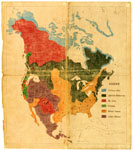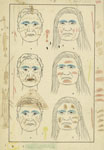|
|
||||
Edward SapirEdward Sapir (1884 - 1939), a German-born ethnologist and linguist, was hired in 1910 to head the newly formed Anthropology Division at the Geological Survey of Canada (now the Canadian Museum of Civilization.) One of the most brilliant students of anthropology pioneer, Franz Boas, the meticulous, highly educated Sapir was a good fit with the Survey's policy of precise original research based on fieldwork. Three weeks after joining the Survey, Sapir was on Vancouver Island starting up a three-month program of fieldwork with the Nuu-chah-nulth (Nootka) that was to evolve into a major four-year study. Sapir was an energetic, take-charge leader, and the Anthropology Division quickly blossomed under his direction. In a few short years, it grew from a single employee (Sapir himself) into a dynamic cadre of full-time employees, supplemented by seasonal specialists carrying out systematic fieldwork across the country in ethnology, linguistics, archaeology and physical anthropology. The division's objective was to gather comprehensive and reliable information on the cultures and languages of the First Peoples of Canada, with corresponding work in archaeology and physical anthropology. In 1910, Sapir established a new classification system based on the anthropological concept of culture area. Exhibitions were planned for a new Anthropology Hall, which was installed in 1912, and public programming, including lectures, was established. During his 15 year tenure at the Geological Survey of Canada, Sapir hired a number of anthropologists who went on to make major contributions in recording the lifestyle, customs and thoughts of Canada's Aboriginal peoples. These included Marius Barbeau, a prolific ethnologist also interested in folklore; American-born archaeologist, Harlan Smith; and Diamond Jenness, one of two ethnologists employed to lead a Canadian-sponsored Arctic expedition. Physical anthropologist, Francis H.S. Knowles, William Wintemberg, a specialist on Iroquoian prehistory, and Frederick Waugh, were other notable additions to the staff. James Teit, an important collaborator of Franz Boaz, was also hired by the Division. In addition to his administrative work, Sapir also conducted further research into the languages of the Mackenzie River Basin and northern British Columbia, eventually connecting them with two apparently dissimilar Pacific Coast languages, Haida and Tlingit. He also developed an interest in philosophy and psychology and contributed poetry to such magazines as the New Republic, Nation and Poetry. Sapir moved to the University of Chicago in 1925 where he continued his linguistic studies as a professor of anthropology and linguistics. He later served in a similar capacity at Yale University. One of the great linguistic scholars of his time, he died in 1939 at the age of 55. BibliographyBy Edward Sapir, 1910-1925:
About Edward Sapir:
|
Bibliography · Links · Credits · Index







